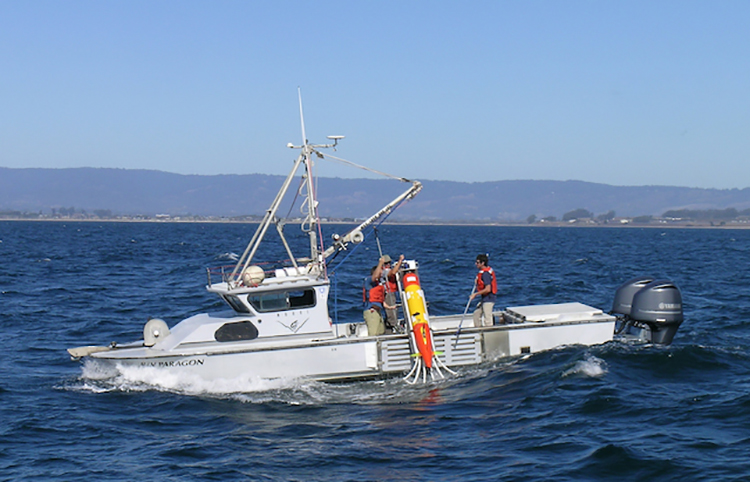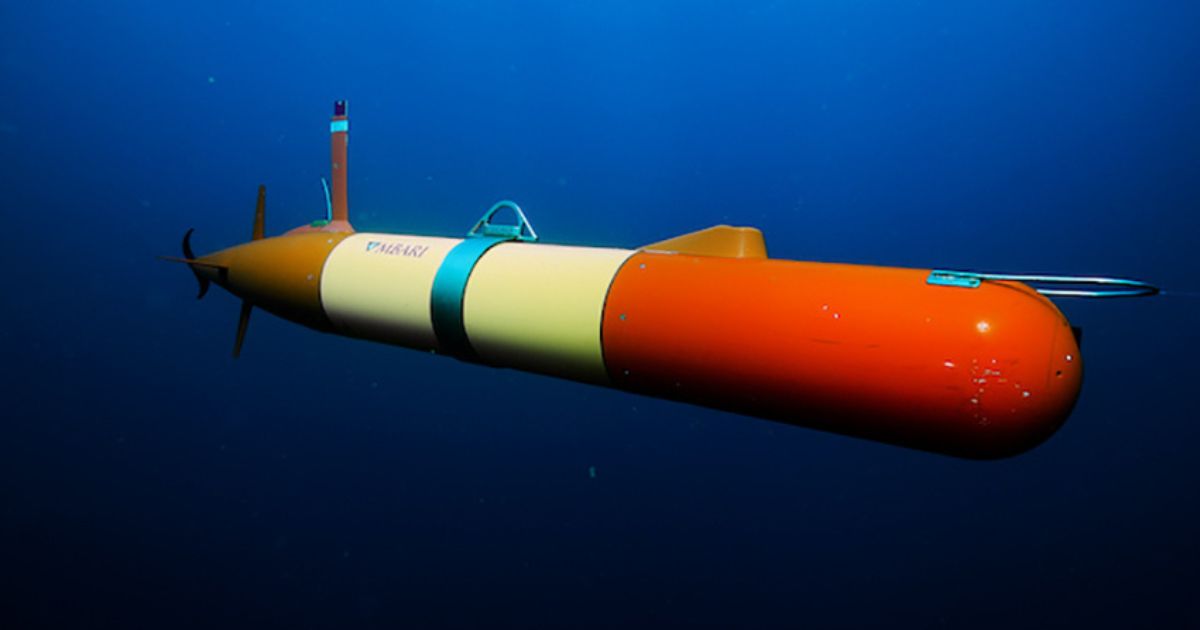In a major step forward for monitoring the biodiversity of marine systems, a new study published in Environmental DNA details how MBARI researchers are using autonomous underwater robots to sample environmental DNA (eDNA). eDNA allows scientists to detect the presence of aquatic species from the tiny bits of genetic material they leave behind.
This DNA soup offers clues about biodiversity changes in sensitive areas, the presence of rare or endangered species, and the spread of invasive species—all critical to understanding, promoting, and maintaining a healthy ocean.
For the study, researchers combined two novel autonomous platforms developed by MBARI: the long-range autonomous underwater vehicle (LRAUV) and the Environmental Sample Processor (ESP). The LRAUV is a nimble robot that can travel to remote areas of the ocean for extended periods of time. The ESP is a robotic “laboratory-in-a-can” that filters seawater and preserves eDNA for future study. By equipping an LRAUV with ESP technology, researchers can expand the scale of ocean monitoring over time and space. By comparison, traditional sampling of eDNA in the ocean requires weeks on an expensive research vessel limited to a localized area. Technology innovations like this are revolutionizing ocean conservation efforts.
“We know that eDNA is an incredibly powerful tool for studying ocean communities, but we’ve been limited by what we can accomplish using crewed research vessels. Now, autonomous technology is helping us make better use of our time and resources to study new parts of the ocean,” said Kobun Truelove, a biological oceanographer at MBARI and the lead author on the paper.
Environmental DNA (eDNA) helps researchers identify marine animals by the DNA “fingerprint” they leave behind. Video: © 2022 MBARI
Marine biodiversity is a measure of the abundance of individuals and species in the ocean. This interconnected mosaic of organisms—from the smallest plankton to the largest whales—supports food webs, produces the air we breathe, and regulates our climate. Autonomous tools like the LRAUV and ESP enable MBARI researchers to maintain a persistent presence in the ocean and monitor changes in sensitive ecosystems in ways that were not possible previously.
“Organisms move as conditions change in our oceans and Great Lakes, affecting the people and economies that rely on those species. We need cheaper and more nimble approaches to monitor biodiversity on a large scale. This study provides the synergistic development of eDNA and uncrewed technologies we need, in direct response to priorities laid out in the NOAA ‘Omics Strategic Plan,” said Kelly Goodwin, a co-author on the study and collaborator at the National Oceanic and Atmospheric Administration (NOAA).
For this research, MBARI collaborated with researchers at the NOAA Atlantic Oceanographic and Meteorological Laboratory and the University of Washington to complete three expeditions in the Monterey Bay National Marine Sanctuary. The team coordinated sample collection between MBARI’s three research vessels, the NOAA Fisheries ship Reuben Lasker, and a fleet of MBARI’s LRAUVs.
A ship-based team lowered bottles to a specific depth to collect and preserve water samples. Meanwhile, an LRAUV equipped with an ESP autonomously sampled and preserved eDNA at similar locations and depths. The eDNA samples were returned to the lab for in-depth sequencing.
MBARI’s Environmental Sample Processor (ESP) is game-changing technology to autonomously collect, preserve, and analyze eDNA. Video: © 2022 MBARI
Related organisms share common sections of DNA, known as gene markers. For this study, researchers analyzed eDNA samples with a technique known as metabarcoding. This method looks for short DNA excerpts and provides a breakdown of the groups present in the sample. This technique is especially helpful for translating eDNA data into a measure of biodiversity. The researchers analyzed four different types of gene markers, each representing a slightly different level of the food web. Together, the results yielded a more holistic picture of community composition. The samples collected from research ships and autonomous vehicles revealed similar patterns of biodiversity.
Truelove noted that the findings from the study mark an exciting step forward for monitoring marine ecosystems. “This work is all about increasing the scale of eDNA research. Instead of looking at an individual species, we can start to more broadly characterize biological community structure in the ocean,” he said.
“Good data are the bedrock of sustainable ocean management,” said Francisco Chavez, MBARI Senior Scientist and a co-author of the study. “Regular environmental DNA monitoring tells us who is there and what is changing over time. When it comes to understanding the impacts of climate change—one of the biggest threats to ocean health—this information is essential.”
 MBARI researchers launch a long-range autonomous underwater vehicle (LRAUV) from the R/V Paragon in Monterey Bay. These nimble robots can travel to remote areas of the ocean that are difficult for a crewed vessel to access. Image: Kim Fulton-Bennett © 2014 MBARI
MBARI researchers launch a long-range autonomous underwater vehicle (LRAUV) from the R/V Paragon in Monterey Bay. These nimble robots can travel to remote areas of the ocean that are difficult for a crewed vessel to access. Image: Kim Fulton-Bennett © 2014 MBARI
LRAUVs are able to travel for weeks at a time and for hundreds of kilometers. They can enable more frequent sampling in areas of interest than traditional research vessels, which typically only visit remote sites infrequently. Autonomous robots will allow researchers to study previously unsurveyed regions of the ocean. Filling in these data gaps is critical to strengthening global ocean health. Ship-based research will continue to play an important role in oceanographic studies, but adding new autonomous technology to the toolkit will expand capacity for research, monitoring, and resource management. Ultimately, MBARI researchers envision deploying a fleet of LRAUVs equipped with ESP technology.
Support for this research was provided by the David and Lucile Packard Foundation, NOAA/OAR/’Omics, NOAA/OAR/NOPP, and NASA Projects #80NSSC20M0001 and 80NSSX21M003.



